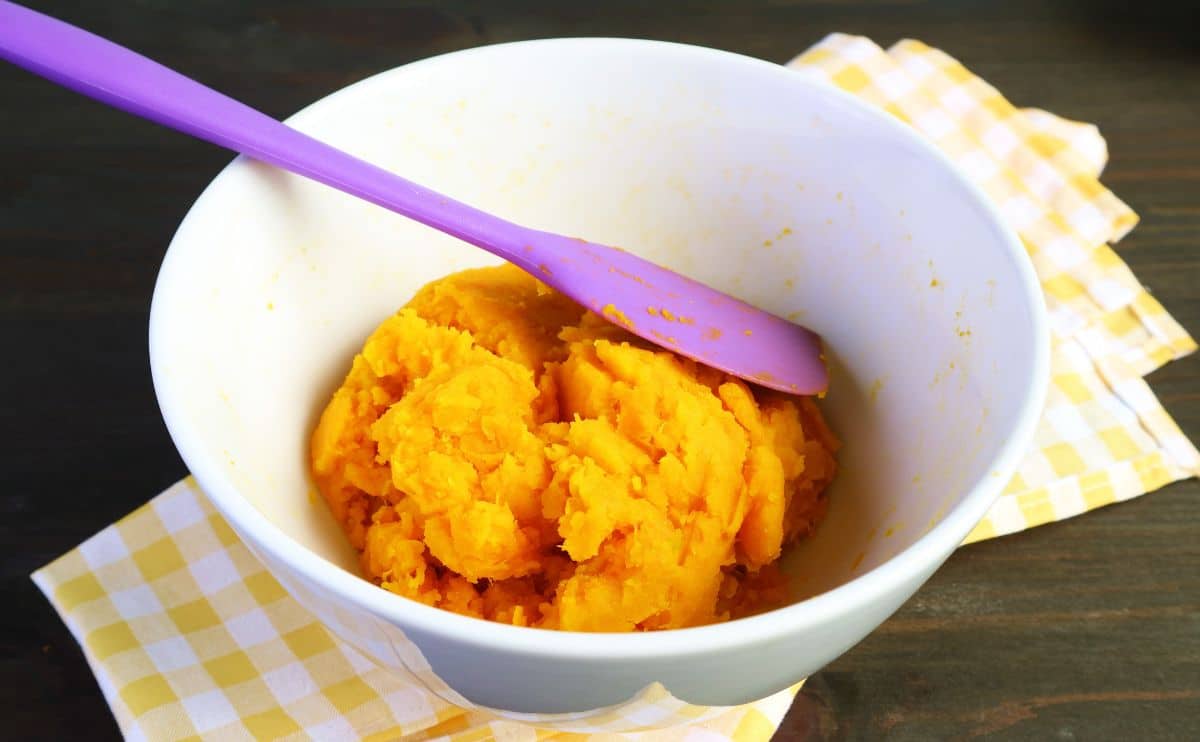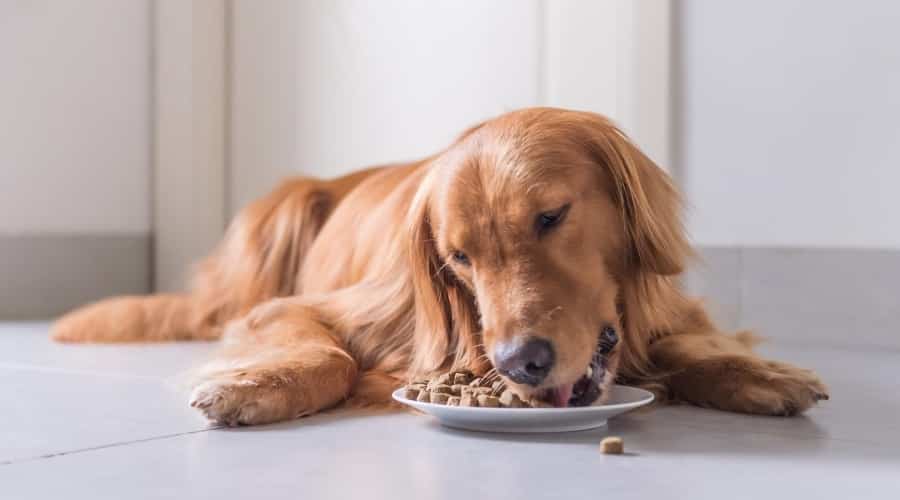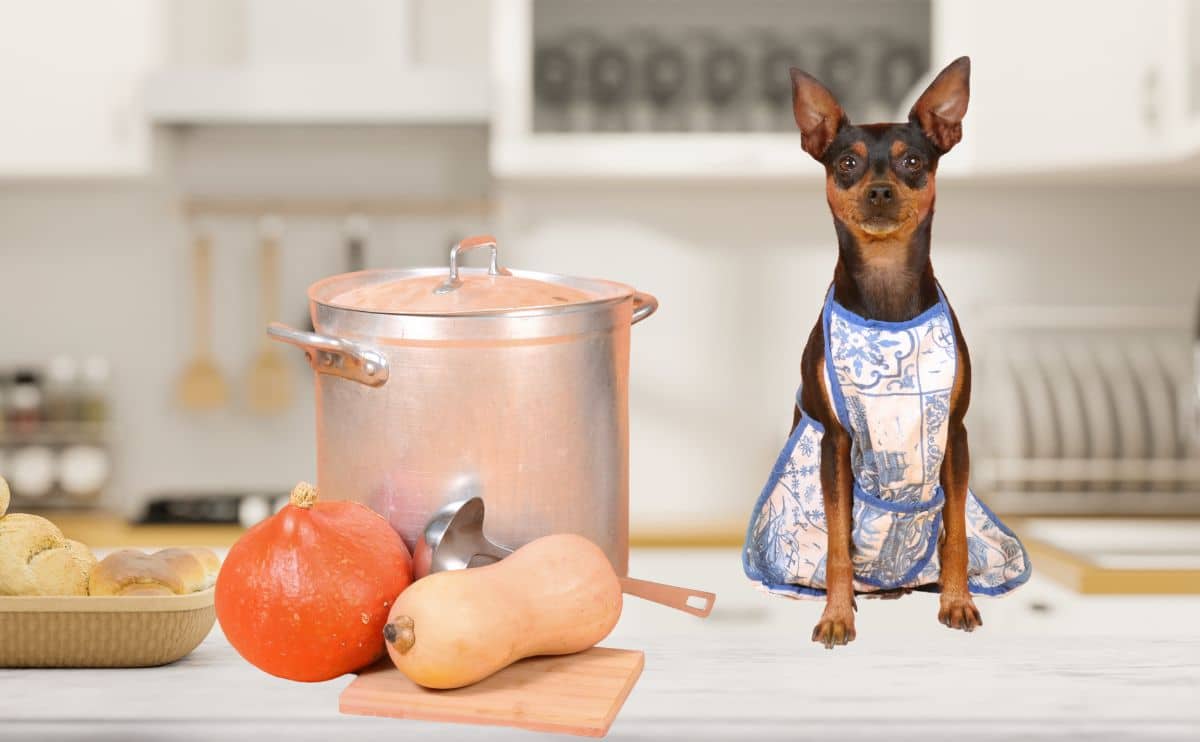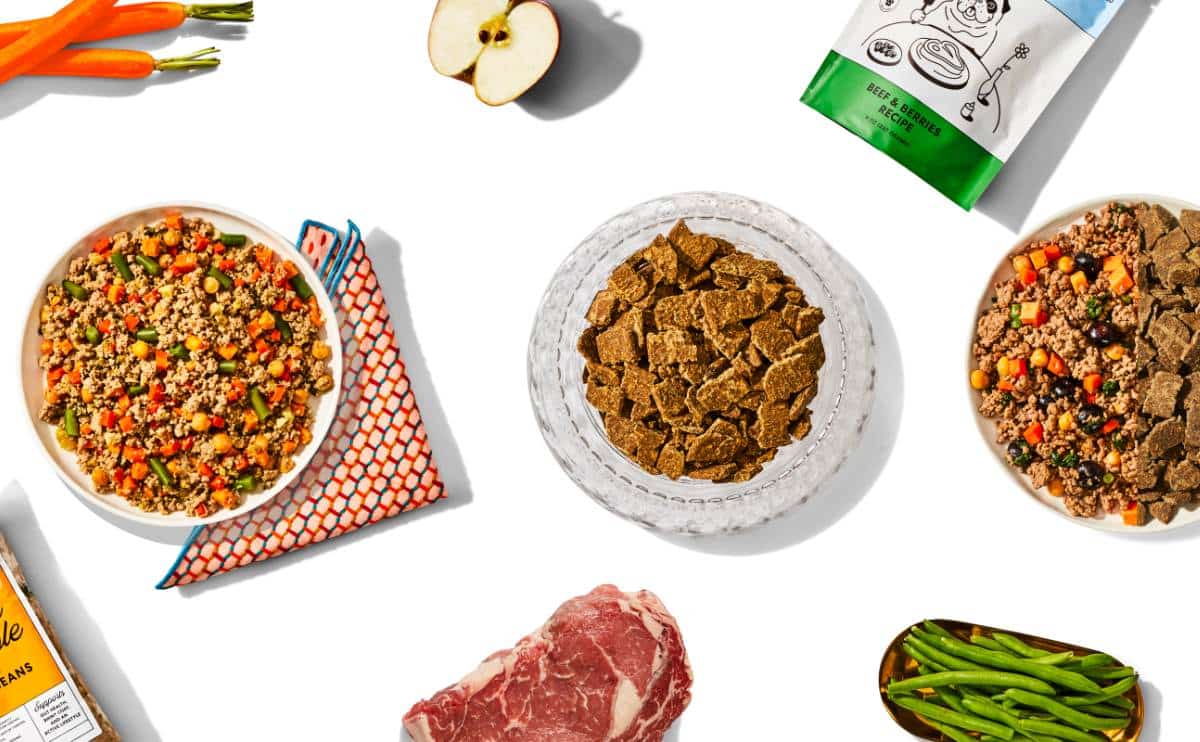Dachshund Feeding Chart: How Much To Feed A Dachshund Puppy
When you purchase through links on our site, we may earn a commission. Here’s how it works.
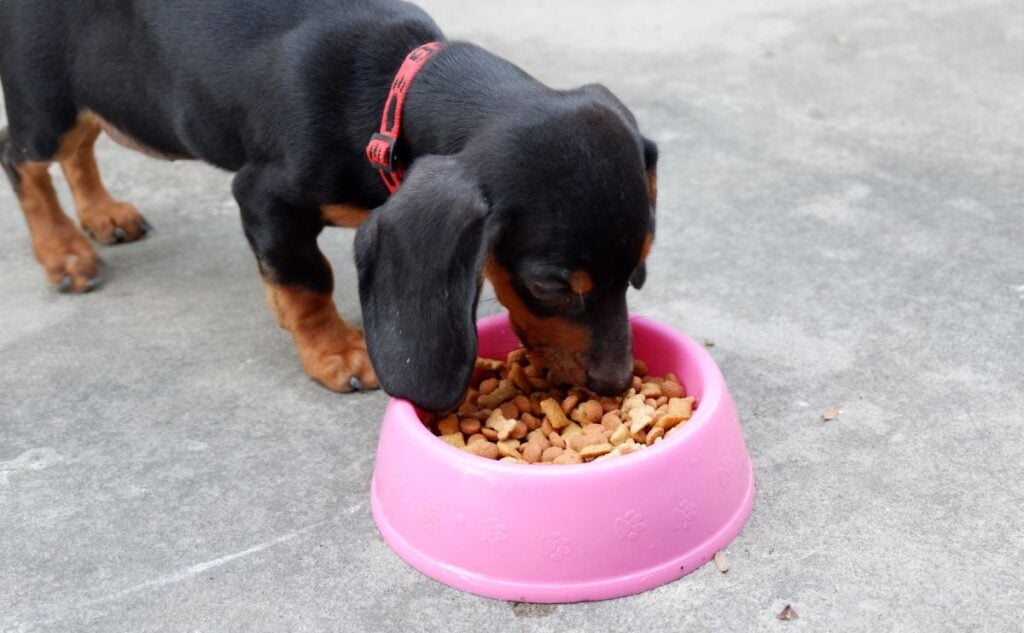
If you’re bringing a Dachshund puppy into your home or looking to improve your Dachshund’s diet, you’ve come to the right place. These small but spirited dogs need careful nutrition to support their growth and overall health. There are two Dachshund sizes, standard and miniature. So, how much food should a Dachshund eat, and what’s the ideal weight for a Dachshund? As a Dachshund mom, I answer these questions and walk you through Dachshund nutrition, the best food choices, ingredients to avoid, and a helpful feeding chart to keep your pup on the right track.
Table of Contents
Dachshund Feeding Chart By Age & Weight
| Age | Puppy Weight (lbs) | Type Of Food | Cups Per Day | Meals Per Day |
|---|---|---|---|---|
| 0 – 4 weeks | 1/3 – 2 | Mothers’ milk | n/a | Unlimited |
| 4 – 8 weeks | 1 – 4 | Mothers’ milk & puppy mush | n/a | 4 – 6 |
| 8 weeks – 6 months | 4 – 16 | Mothers’ milk & puppy diet | 1/3 – 1 | 3 – 4 |
| 6 – 12 months | 12 – 28 | Puppy diet | 2/3 – 1 1/4 | 3 – 4 |
| 12 – 18 months | 16 – 30 | Puppy or adult diet | 3/4 to 1 1/4 | 2 – 3 |
| 18 – 24 months | 16 – 32 | Adult diet | 3/4 to 1 1/4 | 2 |
Please note this is a guideline only for standard-sized Dachshunds – every puppy is different.
Dachshund Breed

Dachshunds charm dog lovers with their long bodies, short legs, and lively personalities. Originally bred in Germany to hunt badgers, these small, fearless dogs display remarkable determination and intelligence. They eagerly dig, chase, and explore, using their sharp noses to track scents. Despite their small size, they carry themselves with confidence and often act as if they are much larger than they are. Owners appreciate their affectionate nature and playful energy, making them excellent companions for individuals and families.
These spirited dogs thrive on interaction and love engaging in activities that challenge their agility and minds. They excel in obedience training when given positive reinforcement and plenty of encouragement. Dachshunds also form strong bonds with their owners and remain loyal throughout their lives. However, their bold nature can sometimes lead to stubbornness, requiring patience and consistency in training.
They stay happy and healthy with proper care, regular exercise, and mental stimulation, bringing joy and companionship to those who welcome them into their homes. They have many coat colors, and their coat doesn’t shed a huge amount. There are also two official sizes of Dachshund:
- Standard-sized Dachshund. They measure between 8 to 9 inches and weigh between 16 and 32 pounds.
- Miniature-sized Dachshund. These measure between 5 to 6 pounds and weigh 11 pounds or less.
Some, like my Doxie, Chips, is in between sizes. This gives way to a third unofficial size known as a “tweenie.” If you’re interested in learning more about the similarities and differences between the two Dachshund sizes, take a look at our standard vs mini Dachshund guide.
How Much To Feed A Dachshund Puppy
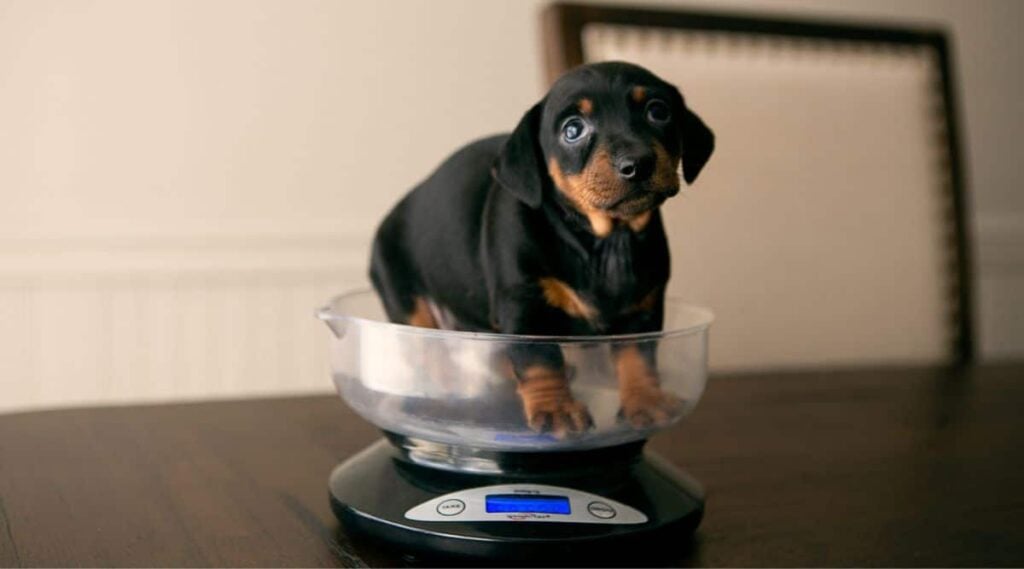
A Dachshund’s dietary needs change as they grow. Initially, they rely on their mother’s milk before transitioning to puppy food. It’s essential to remember that every Dachshund puppy has unique nutritional requirements. Factors such as their size, the type of dog food you choose, and overall health play a significant role in determining how much they should eat.
All puppies need careful attention to ensure they receive the right nutrients to develop into healthy adults. Choosing a diet rich in protein, healthy fats, and essential vitamins will set the foundation for strong bones, healthy muscles, and overall well-being. The following guidelines provide a valuable reference for what and how much to feed a Dachshund puppy.
Weeks 0 – 4
Dachshund puppies spend most of their time with their mother, nursing, sleeping, and staying warm. Their mother’s milk provides all the essential nutrients they need, and they should feed frequently throughout the day. As long as both the mother and puppies are healthy and thriving, there’s usually no need to intervene at this stage. However, consult your vet if you’re concerned that the puppies aren’t getting enough milk or the mother is struggling to produce enough. They may recommend a puppy formula milk substitute to ensure the puppies receive proper nourishment.
Weeks 4 – 8
Some Dachshund puppies begin weaning around four to five weeks, but every pup differs. Some may take longer to show interest in anything other than milk. Most are fully weaned between seven and ten weeks. Signs that a puppy is ready for weaning include seeming constantly hungry, trying to eat their mother’s food, becoming frustrated while nursing, and the appearance of puppy teeth.
Introduce puppy mush when separating the puppies from their mother for short periods. This is a mixture of softened puppy kibble with water or a puppy milk formula. Puppy mush is a gruel-like food that helps them gradually transition to solid meals while supporting their developing digestive system. They should have four to six small meals a day. Patience and consistency will help your Dachshund puppies adjust smoothly to their new diet. Watch this short video on introducing puppy mush.
Weaning can be messy, so keep towels and puppy pee pads on hand to manage spills.
8 Weeks – 6 Months
Dachshund puppies may continue nursing alongside puppy mush until they are around ten weeks old. During this time, their mother’s milk provides essential nutrients. But as she gradually stops producing milk, the puppies rely more on solid food. By the time they reach two to three months, they should be fully transitioned to high-quality puppy food suited to their nutritional needs.
From two to six months old, Dachshund puppies require three to four meals daily to support their growth and high energy levels. Their small size and fast metabolism mean they benefit from frequent, balanced meals rather than large portions at once. Feeding them at regular times throughout the day helps maintain steady energy levels and prevents digestive issues.
6 – 12 Months
As your Dachshund puppy nears their first birthday, it’s time to start transitioning them to adult food. They should continue eating three to four meals daily to maintain steady energy and support digestion. Gradually introducing adult food by mixing it with their puppy food over a week or two can help prevent stomach upset and make the switch smoother.
12 – 24 Months
Once your Dachshund has fully transitioned to their adult diet, it’s essential to continue monitoring their eating habits. If you’re wondering, “How much food should a Dachshund eat a day?” always check the feeding guidelines on your dog food packaging as a starting point. They may need slightly more food if they seem constantly hungry, whereas weight gain could indicate overfeeding.
If your Dachshund isn’t thriving on their diet or shows signs of allergies, consult your vet for guidance. Now that they have reached adulthood, you can reduce their meals to two per day. This adjustment might take time if they were used to eating three or four times a day as a puppy. But most Dachshunds settle into a two-meal routine by age two. Establishing a consistent feeding schedule helps regulate their appetite and maintain a healthy weight.
It is ideal to stick to set meal times as much as possible. However, an automatic dog feeder can help keep your dog’s routine on track if you’re away during mealtimes.
4 Key Differences – Adult Vs Puppy Food

It’s essential to feed your Dachshund puppy food that’s specially formulated for their growing needs. Puppy food is designed to meet the unique nutritional requirements of young dogs, which differ significantly from adult dogs. Here are a few key differences between puppy and adult food:
- Higher Calories. Puppies have a faster metabolism and require more calories to fuel their growth and energy levels.
- More Protein. Puppy food contains higher protein to support muscle development and provide the essential amino acids puppies need to grow.
- Increased Fats. As they grow, puppies need extra energy, which comes from fats. High-quality puppy foods often include omega-3 fatty acids, such as docosahexaenoic acid (DHA), which support brain and eye development.
- Specific Vitamins & Minerals. A puppy’s immune system needs additional support to fight off illness and grow strong. Vitamins and minerals like calcium and phosphorus are crucial for proper bone growth and overall health.
Transitioning your Dachshund from puppy food to adult food between 12 and 18 months is essential. Puppy food is richer in calories and fats to support healthy growth, but as your Dachshund matures, they won’t require as many calories or fats. Continuing to feed them puppy food once they reach adulthood can lead to being overweight and obese.
6 Different Types Of Puppy Food
If you’re unsure what to feed your Dachshund puppy, here are the main diet options. There is no one-size-fits-all answer, so choosing what best fits your puppy’s needs, lifestyle, and budget is important. Regardless of your choice, the food should be nutritionally complete and balanced, meeting the pet food guidelines set by the Association of American Feed Control Officials (AAFCO).
1. Dry Food (Kibble)

Kibble is a popular and convenient option for many dog owners. It’s affordable, widely available, and easy to store. There are many dry food choices on the market, making it simple to find one that suits your Dachshund’s needs and your budget. Many dogs enjoy the crunchy texture, which can also help reduce plaque build-up. However, there are many low-quality kibbles out there, so choosing a high-quality dry food that provides proper nutrition is crucial.
2. Wet Food (Canned)

Canned wet food is another common choice, available in both cans and pouches. It’s often more appealing to fussy eaters due to its moisture content and rich scent. You can also mix wet food with dry kibble for added variety. Wet dog food tends to be higher in protein and lower in carbs, which is often more suitable for dogs. However, it doesn’t provide the same dental benefits as kibble and is usually more expensive.
3. Fresh (Human-Grade)

Fresh dog food is becoming increasingly popular for dogs, particularly those looking for a premium diet. Made from “human-grade” ingredients, fresh food is highly nutritious and offers superior taste and health benefits. While it typically has a shorter shelf life and is pricier than other options, many owners opt for it due to the quality of ingredients and the more ethical and eco-friendly practices.
4. Raw Or Biologically Appropriate Raw Food (BARF)

A raw diet, or BARF (Biologically Appropriate Raw Food), is based on the idea that dogs thrive on the same diet their wild ancestors ate. Raw food advocates claim it’s more natural for dogs. It also provides nutrients often lost during cooking. Raw food may offer more energy and fewer artificial ingredients, which can benefit dogs with sensitivities. If you’re considering a raw diet for your Dachshund, I recommend a raw food subscription. This way, you can be sure the meals are nutritionally balanced and safe, especially when it comes to bones and bacteria.
5. Vegan Diet

Vegan dog diets are a relatively new concept but are gaining popularity, especially among owners looking for plant-based alternatives. These diets contain no animal products and are entirely plant-based. Vegan advocates claim that a vegan diet can provide health benefits, such as improved immunity and reduced inflammation. However, most vets advise against feeding puppies a vegan diet, as they need specific nutrients and calories found in animal-based proteins for healthy development.
6. Home Cooked

Some owners prefer cooking their Dachshund’s meals at home, knowing exactly what goes into their dog’s food. Home-cooked meals like chicken and rice are popular, and this option allows for complete control over the ingredients. However, it requires considerable effort and time. You must also closely monitor your puppy’s nutritional needs and work with your vet to ensure the meals are nutritionally balanced.
Do you need help choosing the best puppy food for your Dachshund? We have a complete guide on the best dog foods for all puppies, including small breeds like the iconic Doxie.
Importance Of High-Quality Dog Food
The food you feed your Dachshund is crucial to their health and well-being. A high-quality, complete, and balanced diet will help your puppy grow into a happy and healthy adult. It can increase their energy levels, support digestion and immunity, and lower the risk of conditions like diabetes and heart disease. Dachshunds typically live for around 12 to 16 years, and providing the right diet is key to ensuring they enjoy a long and healthy life.
5 Ingredients To Avoid In Dog Food
Many of these ingredients are commonly found in low-quality dog foods and offer no health benefits. In fact, some have even been linked to potential health issues in dogs.
- Artificial Preservatives. Ingredients like butylated hydroxyanisole (BHA), butylated hydroxytoluene (BHT), and ethoxyquin are synthetic antioxidants that have raised concerns due to their possible carcinogenic effects. Look for more natural preservatives like vitamin C (ascorbic acid), vitamin E (mixed tocopherols), or rosemary oil. These are safer options for your Dachshund.
- Artificial Colours. Dyes such as caramel, blue 2, red 40, and yellow 5 and 6 are commonly added to pet food to make it more visually appealing. However, these artificial colors have been linked to behavioral problems and cancer in humans and offer no nutritional benefits for dogs. In reality, your Dachshund likely doesn’t care about the color of their food.
- Unnamed Meats. Ingredients like “meat meal” can be derived from unspecified animal parts and often come from lower-quality sources. It’s important to know what you’re feeding your Dachshund, especially if they have a sensitive stomach or allergies, so always choose named meats like chicken, lamb, or beef.
- Rendered Fat. Often used in cheaper dog foods for added flavor, rendered fat comes from animal by-products and can be a source of harmful bacteria. It’s best to avoid foods with this ingredient, as they lack nutritional value and safety.
- Propylene Glycol. Sometimes added to keep semi-moist foods from drying out, propylene glycol is derived from ethylene glycol (more commonly known as antifreeze). It’s highly toxic to pets, and you should avoid any dog food that lists it.
Best Dog Food For Dachshunds
| Puppies | Adults | Seniors | Sensitive Stomach |
|---|---|---|---|
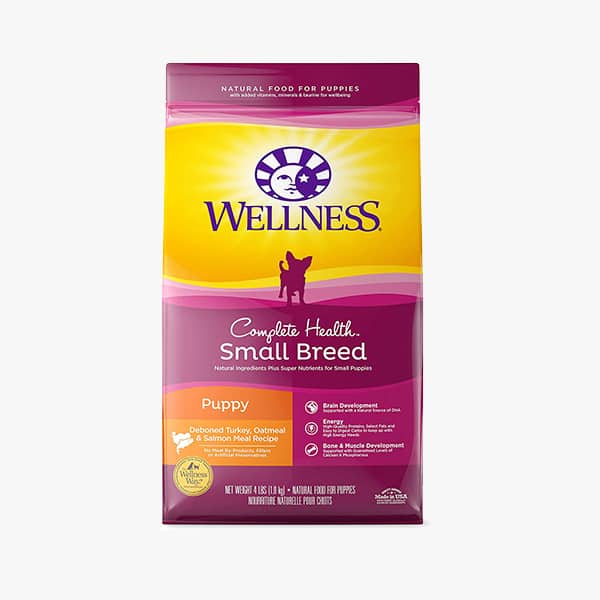 | 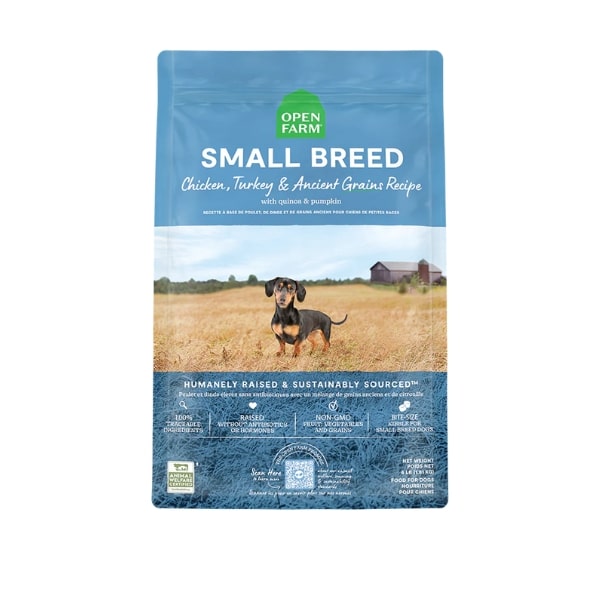 |  |  |
| Wellness Complete | Open Farm | Ollie | Spot & Tango Unkibble |
| View on Chewy | Visit Website | Visit Website | Visit Website |
| Read Review | Read Review | Read Review | Read Review |
Why Is Small Breed Puppy Food Important?
Small-breed puppy food is specially formulated to meet the unique nutritional needs of smaller pups like Dachshunds. They have a higher metabolism, meaning they burn energy faster, and lower fat reserves, making them more susceptible to hypoglycemia. Additionally, if you feed kibble, Dachshunds have smaller mouths, so they may find it easier to eat smaller kibble pieces. This tailored diet ensures they get the right balance of nutrients to support their growth and development.
What Nutrients Do Dachshund Puppies Need? 5 Essentials

- Protein. Protein is vital for various bodily functions, including muscle growth, hormone production, and immune system support. It provides essential amino acids that Dachshunds cannot produce on their own. Animal protein is also packed with vitamins and minerals and offers a flavor that most dogs, including Dachshunds, really enjoy.
- Fat. Despite its bad reputation, healthy fats are crucial for a Dachshund’s development and overall health. Fats provide energy, protect vital organs, promote healthy skin and coat, and support digestion. DHA, an essential fatty acid, is particularly beneficial for brain and vision development in puppies. Healthy fat sources in dog food include chicken fat, meat meal, fish oil, beef tallow, and flaxseeds.
- Carbohydrates. Carbs provide energy and help maintain healthy digestion and immune function. Healthy sources of carbohydrates for Dachshunds include whole grains, brown rice, oatmeal, quinoa, and pumpkin. These ingredients ensure your pup’s diet is balanced and supports long-term health.
- Vitamins & Minerals. These are essential for normal cell function, immune support, and overall well-being. High-quality dog food often contains added vitamins and minerals. Some owners also choose to supplement their dog’s diet with additional vitamins for specific needs.
- Water. Water is fundamental to every aspect of a Dachshund’s health, from nutrient absorption and digestion to regulating body temperature. Make sure your pup always has access to fresh water throughout the day. A general guideline is that a dog should drink about one ounce of water per pound of body weight daily to stay properly hydrated.
The Ideal Weight For A Dachshund
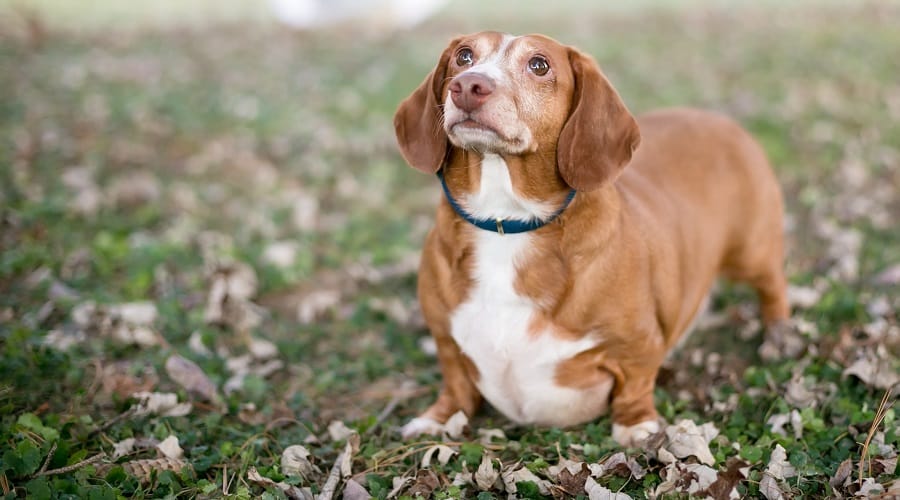
You might be wondering, “How much should a Dachshund weigh?” The ideal weight of a Dachshund can vary depending on factors such as age, sex, and activity level. Their weight changes as they grow and mature. A healthy standard-sized adult Dachshund typically weighs between 16 and 32 pounds and miniatures 11 pounds and under. Their weight determines how much food they should eat to maintain a healthy lifestyle.
7 Ways To Keep Your Dachshund At The Right Weight
Maintaining the right weight for your Dachshund is crucial for their happiness and overall health. Due to their long body and short legs, Dachshunds are prone to intervertebral disc disease (IVDD), which can be worsened by carrying excess weight. Being overweight can lead to a range of health problems that may shorten their lifespan. Here are some key ways to help keep your Dachshund at a healthy weight:
- Always follow the feeding guidelines on the dog food packaging.
- Use measuring cups to portion out their meals accurately.
- Avoid giving too many table scraps or treats in excess.
- Ensure your Dachshund gets daily exercise to maintain a healthy weight.
- Regularly monitor your pup’s weight and adjust their food intake as needed.
- Choose a high-quality dog food that matches your Dachshund’s age, weight, and activity level.
- Opt for low-calorie dog treats; remember that they should not account for more than 10% of your dog’s daily calorie intake.
Frequently Asked Questions
There are many common questions about feeding Dachshund puppies and their diet schedule. If you have a question that isn’t answered below, feel free to ask in the comments, and we’ll find the answer for you.
What Should I Feed My Dachshund Puppy?
Dachshund puppies should eat high-quality, small-breed puppy food. Look for food with higher protein and fat content to support their growth and energy needs. Make sure the food is nutritionally balanced and meets the guidelines of AAFCO for the growing needs of puppies.
How Much Should I Feed My Dachshund Puppy?
The amount of food your puppy needs varies based on their age, weight, and activity level. Follow the feeding guidelines on the puppy food packaging and consult with your vet for personalized recommendations. Use measuring cups to ensure you’re providing the correct portion.
How Do I Know If My Dachshund Puppy Is Eating Enough?
A healthy Dachshund puppy should grow steadily and have a good amount of energy. Monitor their weight and activity levels regularly. If your puppy seems too hungry or is not gaining weight, you might need to adjust their portions. You may need to reduce their food intake if they’re gaining too much weight.
How Much Do Standard Dachshunds Need Feeding Vs Miniature Dachshunds?
The amount you feed a Dachshund depends on their size and age. Standard Dachshunds, which typically weigh between 16 to 32 pounds, generally require around 3/4 to 1 1/4 cups of high-quality dry food per day, split into two meals. Miniature Dachshunds, typically weighing up to 11 pounds, usually need about 1/4 to 1/2 cup of dry food daily, divided into two meals for adults. You should adjust their portions according to their activity level and age and follow the feeding instructions. It’s always a good idea to consult your vet for more tailored advice.
Other Dachshund Must-Have Products
Now that you’ve got the feeding sorted for your Dachshund puppy, it’s time to make sure you have everything else they need. Please look at our puppy checklist, which covers all the essentials for welcoming a new puppy into your home. We’ve reviewed the best dog crates and beds for Dachshunds. As well as the top toys to keep Doxies entertained and mentally stimulated. Don’t forget to consider pet insurance for your Dachshund puppy, too. Our pet insurance experts have reviewed the best options for Dachshund owners.
Do you have a Dachshund puppy? Perhaps you have some tips or funny stories on feeding Doxie pups? We love to hear from our readers, so hit us up in the comments section below.
Why Trust Canine Journal?
Emma is the proud mum of two rescue dogs, Bonkers, a mixed breed, and Chips, a sassy Doxie. Before joining the Canine Journal team, she worked as a full-time dog walker and sitter, caring for a variety of breeds, including several vibrant Dachshunds. Emma is passionate about sharing her expertise and love for dogs with her readers. She collaborates with a dedicated team to ensure that Canine Journal remains a trusted and up-to-date resource for all dog enthusiasts.
